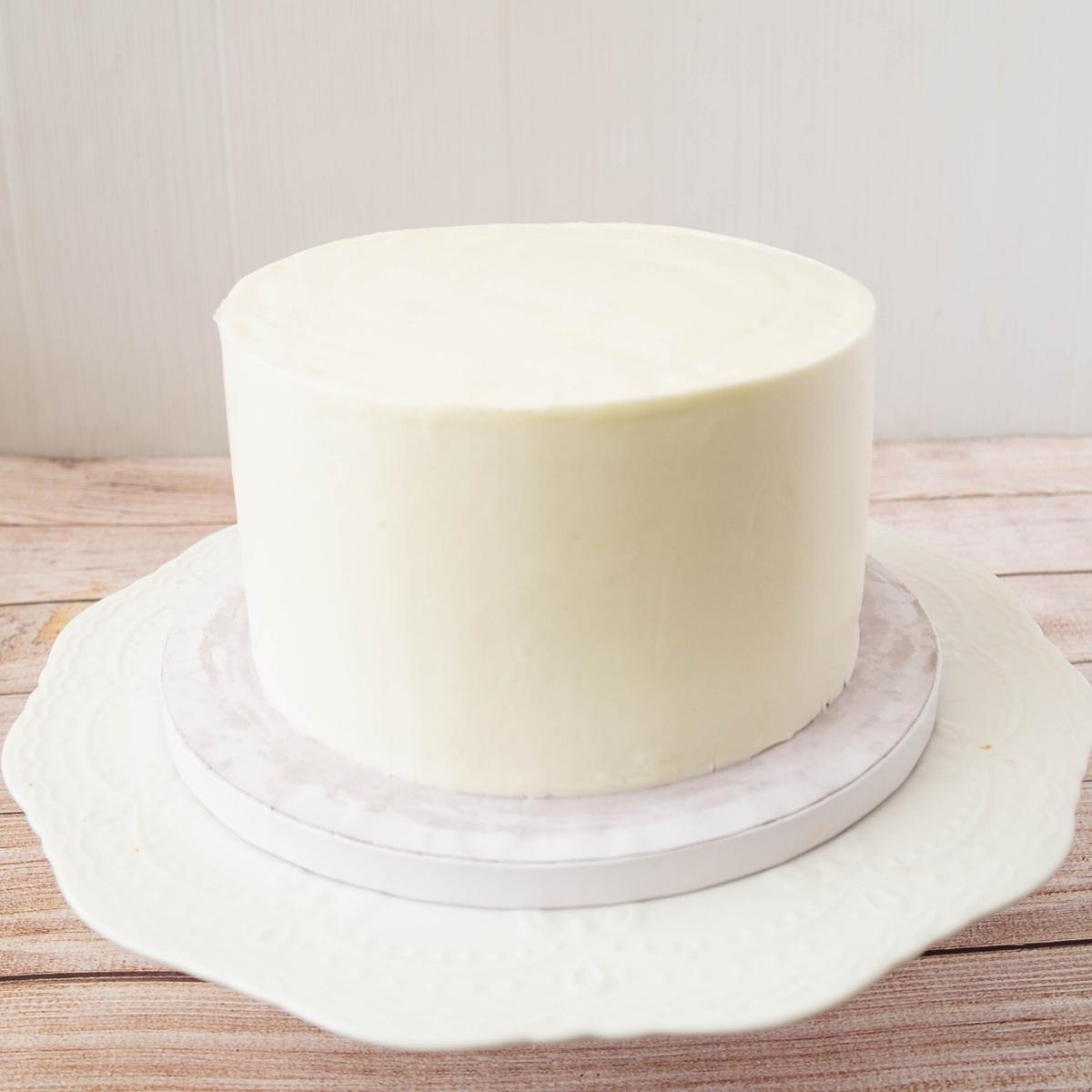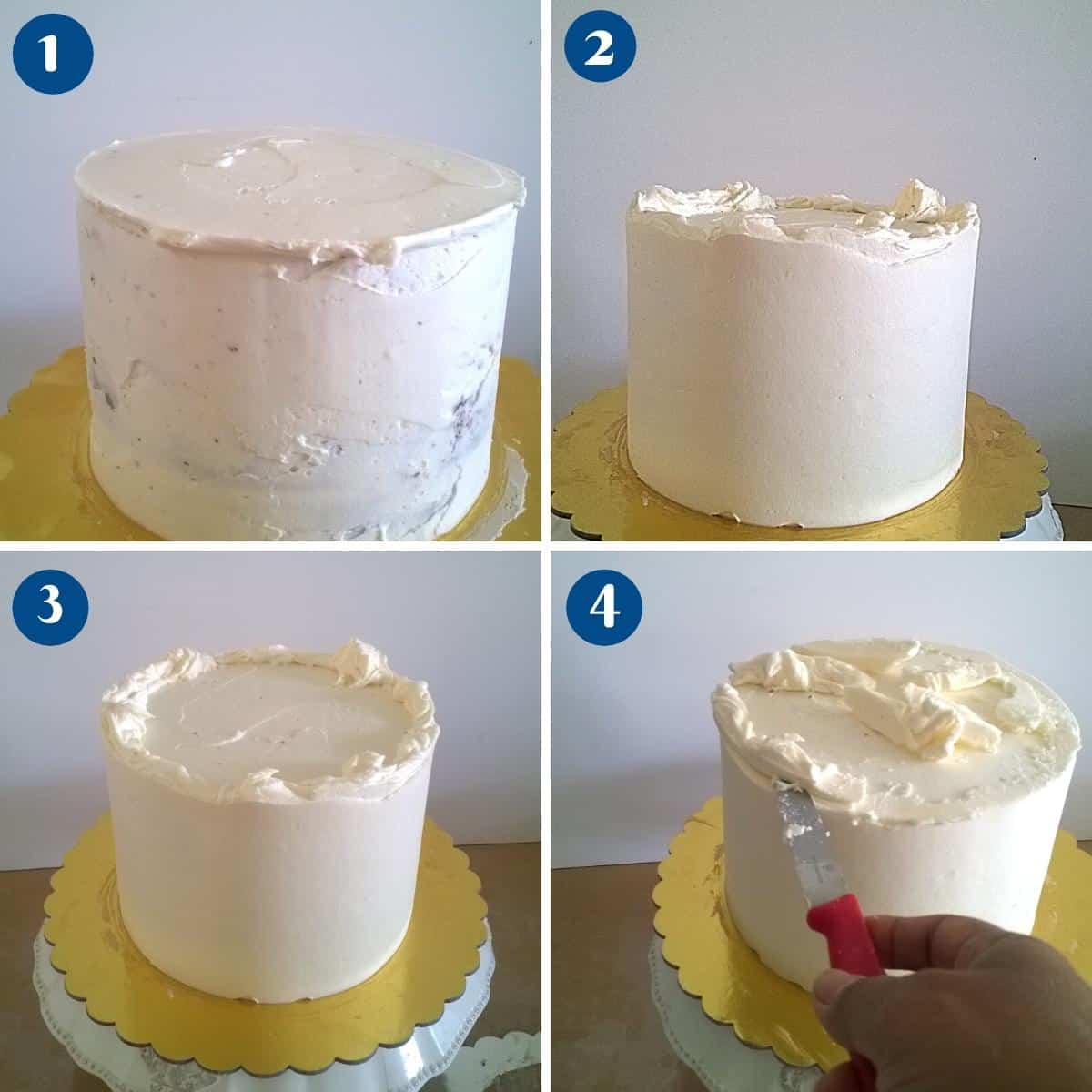Getting a flat and leveled cake actually starts from the basics of making sure you level, tort, and fill your cakes right. And, there are many different methods out there that claim to get the sharpest possible edge on buttercream cakes. Honestly, there is no right or wrong method. The only thing that matters is what works best for you. There is an upside-down method as well as a parchment method. In addition, many are comfortable using acrylic circles. I’m sure they are all good!! Also, if the weather is good where you live, then you won’t need to rush with the sharp edges on your buttercream cakes. But in my case, the weather is hot and humid. So, time is not on my side. As a result, I have to work fast before the condensation starts. And, those of you who live in hot and humid climates will know what I mean by rush. I have shown you two methods for doing this. The 1st method is detailed in the video below (see method one). While the 2nd method is detailed under Method two.
Method one
This method uses a cake board on the top of the cake. The top board is the same size as the bottom board. Furthermore, chilling the cake between steps is very important to make sure you get a smooth finish as well as sharp edges.
Method two
I started with this method and I found that it works best for me. Most importantly, I don’t have to spend money on extra tools such as acrylic discs or risk flipping my cake several times. Especially in the hot and humid weather, I deal with.
Tort, level, & crumb coat.
Bake your favorite cake. When done, cool in the pan for 10 minutes. Then, invert onto a cooling rack and cool completely before decorating.Pro tip – Wrap in plastic wrap and place in the fridge to cool completely before decoratingPrepare simple syrup – cool completely before using.Pro tip – simple syrup is just sugar and water boiled for 3 minutes. It keeps the cake layers moist.Once cooled, cut the domes off the cake layers using a serrated knife. Brush each layer with the cooled, simple syrup.Place a cake layer on the cake board or cake stand.Pro tip -if you plan to move the cake again, it is best to use a cake circle under the cake, so you can pick the cake with its base and without any accidents.Fill the cake – Pipe a buttercream dam on the cake layer (see video). Top with a big dollop of the coconut cream filling – spread evenly with an offset spatula or spoon but within the piped buttercream dam/edge.Next, top the second cake layer on top followed by buttercream dam and filling. Then, place the last cake layer on top.Pro tip – it is best to lift individual cake layers on pieces of clean cardboard or cake lifter so you do not break them from table to cake.Place the cake in the fridge to chill for 10 to 15 minutes.Pro tip – Chilling the cake at this point will ensure the layers don’t move when you frost the outside. Though, if you leave the cake uncovered in the fridge for too long it can dry out. So, 10 minutes is all you needCrumb coat – Spread more buttercream around and on top of the cake. (see video). Chill the cake for another 15 to 30 minutes.Pro tip – A crumb coat is a thin layer of frosting all around the cake, then chilled. Once you chill the crumb coat it ensures that all the crumbs stick to the cake. Shilling the crumb-coated cake will ensure no cake crumbs get into the rest of the buttercream and you will have a nice clean cake.
Sharp edges
Once the crumb coat is chilled – add a big dollop of frosting on the top of the cake. Smooth around. Let chill in the fridge for at least an hour or so for it to firm up.Pro tip – A straight-edge spatula for the top, an offset spatula, and a bench scraper for the sides work better.Next, frost the sides of your cake – leaving a large lip of frosting on the top. Just as I have shown in the progress pictures. Smooth the sides as best possible. Chill the cake for an hour or more again.Pro tip – You want the frosting to set really well so you can actually use a knife to cut it.Next, use a sharp knife with hot water. Cut the extra lip of frosting you created on the top, flush with the top of the cake. This should give you a sharp edge.Pro tip – the hot water gives a smoother, sharper, neater cut. Also, it makes it easier to cut.Final touches – If necessary, add a thin layer of frosting to take care of all the air pockets or uneven spaces.Pro tip – do not add too much frosting otherwise you will have to create the sharp edges again.Once the frosting is set. Ensure you have a level cake. Use a bench scraper dipped in hot water to smooth the sides of the cake.
Frequently asked questions
You may also like
Did you LIKE this recipe? Save it for later. You can find my recipes on Pinterest. Follow me on Facebook, Twitter, and Instagram.Subscribe, and I’ll send you new recipes right to your inbox. Thank you for sharing - Save for later










